Creative Take on Damask Motifs
This week, we look at damask motifs from a new perspective. I challenge you to make this traditional motif your own and use it in your art!

It all started from a dream I saw a few days ago. “You should wear more decorative clothes, Paivi,” I was telling myself. “Like the old historical dress that you had at a ball as a teenager.”
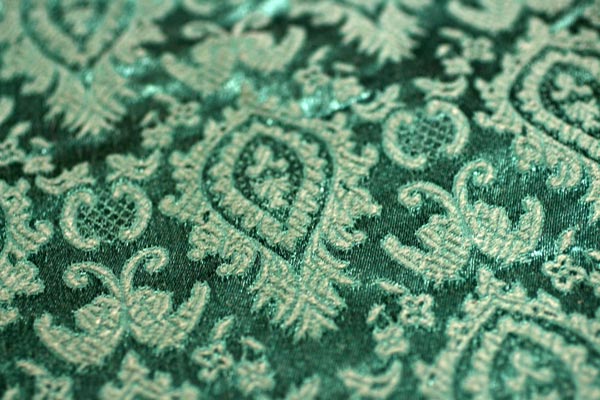
I still have the dress. It has damask motifs – woven ornamental patterns that seem to never go out of date (more about their history). The idea of perfecting not only the actual swirls but also the shapes between is a good drawing practice that doesn’t have to be boring at all!

This week, I played with colored pencils mostly, but in 2015, I made a mixed media piece called Rococo. So check out this post too!

Damask Lady
The reason for my dream was an unfinished page in my colored pencil journal. I had started it at the end of last year but found it terribly uninspiring. I didn’t feel any connection with the figure, and she looked like someone had forced her to be there. In a way, that had happened. After a series of big paintings, I was knackered, as readers from the UK and Australia would describe. I had no motivation to take a brush and only a little to do something with colored pencils.
First, I added a bit of watercolor to cover white and then colored intuitively without any predefined ideas or models.
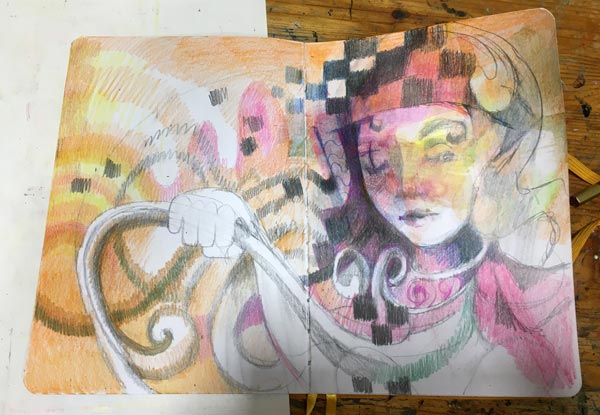
Sometimes it’s just that when you are tired, it’s best to leave the piece and come back later, even if it would be a tiny spread in a small journal. After the dream, I knew what to do: play with damask motifs!

I feel drawn to this damask lady. She looks both curious and self-confident – everything I would like to be in this new year!
Looser Damask Motifs – Nature
I got so inspired by coloring the swirly lady that the next spread was born quickly. Again, first some watercolor splashes, and then details with colored pencils.
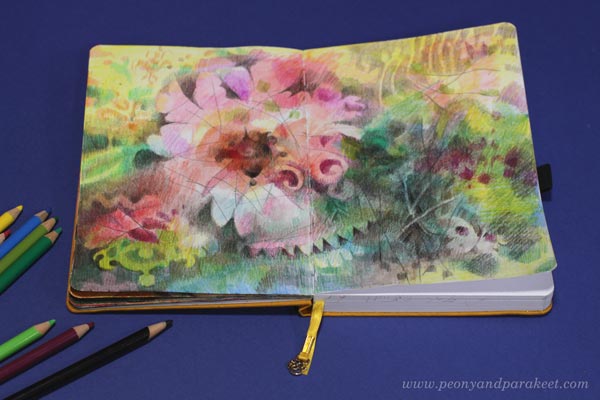
If you compare the flowery spread above with the portrait below, you see the change in looseness. The flower is much freer than the lady, but I like both. I like how damask motifs can be seen as a part of nature – snow on trees, water drops, butterfly wings and their spots. But I also like how they can be more architecture- and design-related and a part of human fantasies and mysteries.
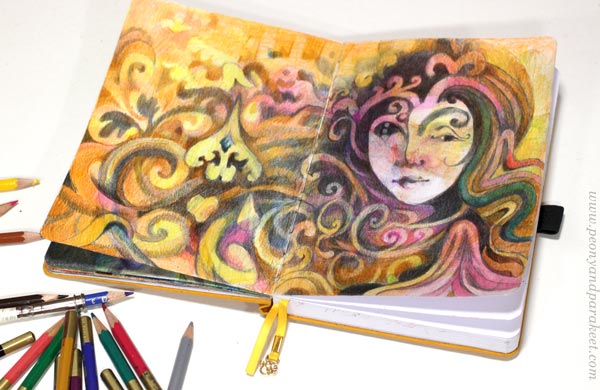
Which take do YOU like more?
Sketching a Damask Motif
Next, I wanted to go even further in stiffening the expression. I would design a damask-inspired motif so that there would be no looseness at all.

I started by sketching the motif in the middle of the spread, using the fold as a guide to achieving the required symmetry. In damask motifs, the negative – the shape of the background – is as important as the positive is. So after the careless sketch, I then went through the surrounding area and adjusted its swirls.

This motif felt like a forbidden fruit. I was surprised to hear myself saying: “You have crossed the line now, Paivi. Even if you always paint the inside, now it will be reverse – illustrating the outside world.” I didn’t get this first at all – I thought I was just drawing was a simple flowery ornament inspired by damask motifs!
But when I was making the finishing touches, I realized that my drawing did illustrate the outside world – our living room: a wooden ceiling, windows on the left, a wall rug on the right, a vanda orchid hanging without a pot, and the snake plants growing lower.

Here’s a picture of my vanda when it was blooming in 2020!
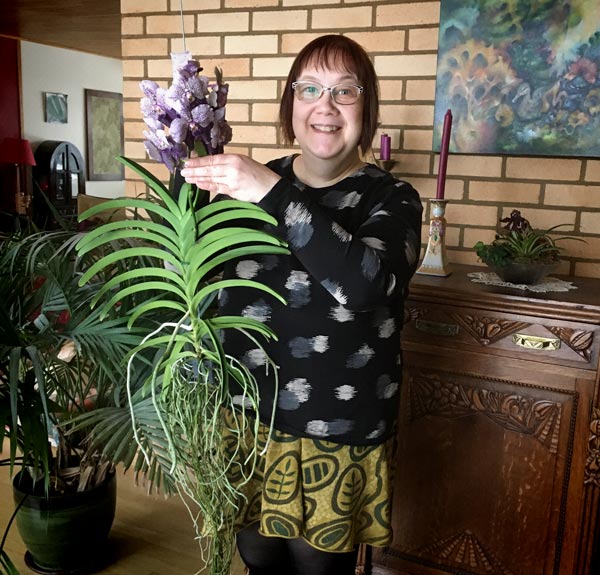
This spread is not loosely made at all, and yet I find that the looseness is how I unconsciously picked and interpreted the subject.

Which of the pieces of this post inspire you the most?
Are you inspired by the stiffness or looseness?
How do you want your damasks to look?
Please leave a comment! It would be so interesting to know!
18 thoughts on “Creative Take on Damask Motifs”
Comments are closed.
That plant is amazing!!! How do you water it? You have a magic touch with orchids i think. I will think about the artistic questions momentarily….just want to write about the orchid.
Yes, vandas are amazing! I water it by placing its’ roots to a water bucket. I let her be there for a couple hours. However, I definitely do not have a magic touch with orchids. I bought the vanda when she was blooming but she hadn’t bloomed since. Plus: I have thrown away several orchids because they haven’t been a good fit! I like plants that need a lot of water and my current orchids are mostly those. But I have been able to get a couple of orchids to bloom last year and I hope to achieve the same this year too. And Patricia, your wonderful orchid that you gifted to me brought all the other orchids to my life, so thank YOU!
My preference is for the vanda. To me a motif is stiff if it has total symmetry, repetition or straight lines. I use damask patterns rarely and very faintly, as backgrounds only. The vanda’s curves, its differences between opposite segments (like your window and wall rug), the interior changes such as colours, all relax what otherwise would be stiff to my eye. I love it!
Thank you, Cathy!!
I like how you transformed the lady! She actually looks tired and a bit confused in the first picture, although I thought the design was interesting. But the finished Damask Lady is vibrant and full of meaningful movement. I often struggle with changing a piece I’m not happy with so the transformation inspires me. Also I like Rococo because you created something abstract from something strictly symmetrical.
Thanks, Cheryl! This often helps when I change a piece: I pick details I don’t like one by one and change them without thinking the big picture too much. Usually when everything appeals to me, the overall composition is quite ok too!
You always have such an amazing way of looking at the world–and reinterpreting it. Happy new year Päivi!
Thank you, Heather!
I love them all, however the loose flower piece is my favorite. I love orchids. I have 8 and 2 are blooming now. Patience is the key to growing orchids. They love to be touched.
Thank you, Phyllis! I agree that orchids need patience and attention. I find them truly inspiring.
These are wonderful Paivi. Firstly I was drawn to the loose flower and not as interested in the tight damask motif. Then I saw the motif with all the background finished and was fascinated by how you intuitively brought in your surroundings. I’d love to try that.
What a beautiful plant, the Vanda. I’ve never seen one. Happy New Year
Thank you, Debbie! Isn’t it interesting how short the path can be between design and illustration!
I never cease to be amazed at your creativity! I love the Nature one best but they are all great. Well done Paivi! ……. and a Happy New Year!
Thank you, Joan!!
These are all beautiful, but my favorites are the lady in her final version and the Rococo piece. The combination of stiff on loose inspires me most. It’s like when we look at a colorful scene and our eyes focus sharply on only a part, but we still feel enveloped by all of the beauty we sense is there.
Thank you, Melissa! I like to think that art can be created like changing the settings of a camera: to bring focus on only part of the picture, not all.
Ehat is the brand of your art journal? (Jossa keltainen nauha) does it work with all mediums? I know you used Moleskines before, is that aldo M?
The brand is Archer & Olive. The paper is smooth and thick and it tolerates some watercolor but it’s not watercolor paper. So not for all mediums but the thickness is great and I like how white the paper is and how well my pencils take it. More info: https://www.peonyandparakeet.com/starting-a-colored-pencil-journal/